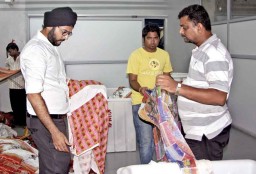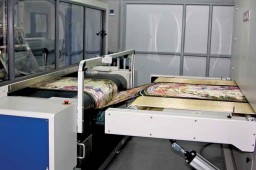
Specialising in the development of textile design through modern tools, expert workforce and computerized systems, has enabled Sahiba Limited to be amongst the pioneers in textile manufacturing, providing leading services to the fabric and garment industry not only in India but also globally. The most recent addition to their value adding capabilities is the foray into digital textile printing, allowing the company to innovate keeping in mind the current demand and trends in the fashion industry. Jash Saluja, Director, Sahiba Limited talks exclusively to Apparel Online on the digital textile printing market and its future for the industry.
Commonly considered as an expensive printing solution and not a volume business in comparison to rotary and screen printing, still digital printing is increasingly growing in demand, both in domestic and export market. “Digital textile printing is an expensive source of printing solution, is a ‘myth’,” asserts Jash. In reality, when compared to screen printing, digital textile printing involves minimal labour and space requirement, offering short run printing advantages with lower water and power consumption, resulting in less ink usage and waste compared with screen printing. Also, printing digitally offers a greener advantage, taking into account the additional chemistry and chemical waste from screen production. “From a business perspective, there is relatively low capital investment requirement to establish a digital textile printing setup, especially compared to rotary screen printing production, making it possible to start small and expand as your business grows,” adds Jash.

According to InfoTrends, a leading worldwide market research and strategic consulting firm, the key trends driving the growth of digital textile printing include, risk mitigation from the retailer and brand community; while on the technology side, the emergence of high quality, high speed inkjet print heads, the availability of moderately priced solutions that enable new market entrants and open system inkjet print heads that allow for multiple ink suppliers resulting in lower ink prices. “The potential for digital printing to influence the printed textile market has long been promised, yet only now, with the new dynamics on the demand generation side and the introduction of super high-speed digital printing systems with open ink configurations, are fabrics printing companies able to meet new customers’ demands,” reveals Jash.
Digital printing of textiles worldwide is expected to drive a market for related digital hardware and ink from US $ 484 million in 2011 to more than US $ 2 billion in 2016, reflecting a compound annual growth rate (CAGR) for that interval of 33.3 per cent. Keeping in mind the growing demand for digital print technology and tapping into this unexplored market with high potential for growth, Sahiba Limited intends to feed the demand for both domestic and export market. “The growing trend towards mass customization, which supports a one-on-one marketing strategy, will increase the demand for integrated solutions that support agile manufacturing, indicating a bright future for digital printing due to its special nature like sample production and increasing competitiveness to normal prints,” maintains Jash.
“The competitive edge of the digital print technology is that it doesn’t bind you on any basis. Be it, in terms of colours, products, designs or fabrics. The machines installed with us are capable of processing and printing on any type of fabric, also on the ‘skin’. And since, there are no limitations of any bounds, we are open to include every possible option in our kitty, be it from garmenting to accessorizing or furnishings.” – Jash Saluja
Though the trends in terms of design is different for both domestic and export market, Sahiba’s design studio with professional designers from around the world, enables the company to offer the latest trends and address demands of both these markets. “We have installed some of the best world class software which allows the designers to experiment and evaluate strongly with designs and colours,” states Jash. As both the markets have different design sensibilities the challenges are also varied. “Domestic markets tend to be more challenging, as it requires more creations along with higher incidences of novelty in collections. Internationally, we play around with mostly floral, geometrical, and abstract designs, which are acceptable and admired across most zones of the world,” shares Jash.
To cater to both the markets, Sahiba has installed two Italian machines within its T&M studio that uses international quality ink and supports reactive printing. “It can print up to 72 inches with a head of 14 mm height, high resolution printing quality of 2400 Dpi and a starting size of 3.5 picoliter. This not only extends a crystal eye sharpness but also lucid clarity and accuracy to the imagination of the design,” claims Jash. Both the newly installed machines have up to 10 colour combination, which is amongst the forte of European manufacturers across the globe, removing restrictions on the number of colour or sizes of the repeats, enabling easily available photo realistic images. Further, the machines are capable of printing 2 lakh metres per month at full capacity and going forward, the company will double its capacity within the time-frame of six months by installing another two machines of the same make and technology.






